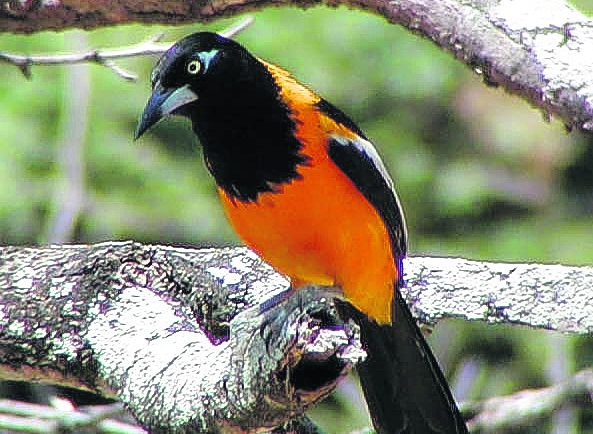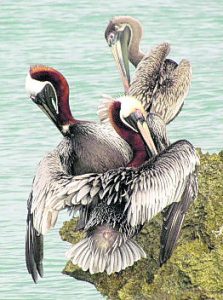 Brown Pelican
Brown Pelican
A very large, dark-bodied bird, unmistakable with its long bill and gular pouch. Watch for them sitting on pilings and zooming along the beach in front of your resort. You’ll probably see them feeding, too, plunging into the sea from the air, then rising with their pouch full of sea water and, if successful, a fish. Non-breeding plumage shows a white neck, and immatures are all dark with a white belly.

Troupial
Certainly one of most striking of Aruba’s native birds, the Troupial is a large oriole with sharply contrasting bright orange and black pattern, with bright blue around the eye and at the base of the bill. The Troupial’s loud, piping song is thrilling to hear. Troupials make stops at some of the resorts to look for food but they often typically don’t stay for long. Take a trip to the hills of Arikok National Park to make sure you don’t leave the island without a look and a listen to this special bird.
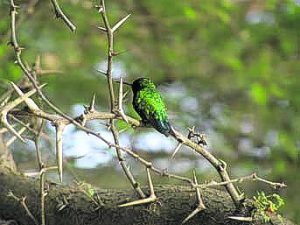 Blue-tailed Emerald – Blenchi
Blue-tailed Emerald – Blenchi
One of two hummingbird species that occurs regularly on the island, and the most common and widespread of the two. You’ll undoubtedly see a few individuals of this species around your resort, frequenting blooming ornamental plantings. A good, close look will reveal a green that is brilliant, almost metallic. Males are all green with a rather short, dark blue tail that often appears black. Females and immature have green backs and whitish under parts.
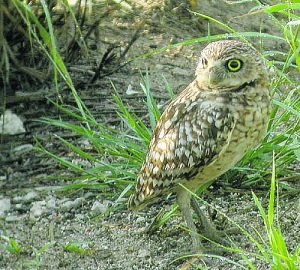 Burrowing Owl – Shoco
Burrowing Owl – Shoco
The Burrowing Owl is a buffy-colored, long-legged owl with large, yellow eyes. This diurnal species can be seen sitting in open areas in small family groups, apparently unphased by the hot afternoon sun. Burrowing Owls are much loved by the native islanders and appear on Aruba’s currency and postal stamps. Sadly, their populations seem to have declined greatly.
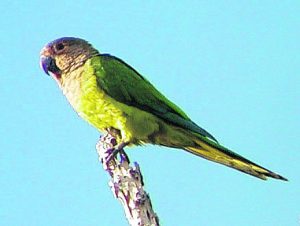 Caribbean Parakeet- Prikichi
Caribbean Parakeet- Prikichi
If we go back 10 years ago, visitors of Aruba could delight at seeing flocks of native, wild parakeets roaming the countryside, sometimes coming near some of the resorts that maintain native vegetation. Unfortunately, this bird has experience steep declines in recent years, apparently due to introduced boa’s. Although efforts are underway to eradicate the snake, such a task is proving difficult.
To try and locate Brown-throated Parakeets, listen to their loud, raucous shrieks. The birds may appear green at first glimpse, but a closer view will reveal the beautiful bluish colors in the wings, the yellow under the tail, and the yellowish eye ring. Parakeets from Aruba are described as a distinct subspecies and are drabber than the subspecies from Curaçao and Bonaire, which have brighter yellow on the face and throat.
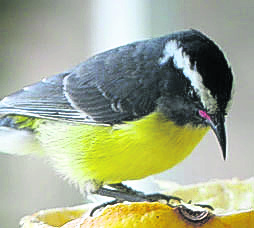 Bananaquits – Barica Geel
Bananaquits – Barica Geel
A lively little bird with blackish back and head, white stripe above the eye, and bright yellow belly. Bananaquits may remind visitors from the eastern U.S. of the familiar and beloved backyard bird, the chickadee, which is why we fondly refer to the Bananaquit as the “chickadee of the Caribbean.” The locals call them chibichibi (in Dutch, zuiker diefje), and when you hear them, you’ll know why. They are common throughout the island including around hotels and if possible, may arrive at your breakfast table to sip juice or sample the jelly or syrup. They can be drawn to the balcony of your room by setting out fresh fruit or juice in a shallow bowl or dish. The buzzy song, repeated all day, soon becomes familiar and delightful background “noise” on Aruba. q


